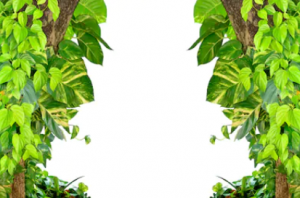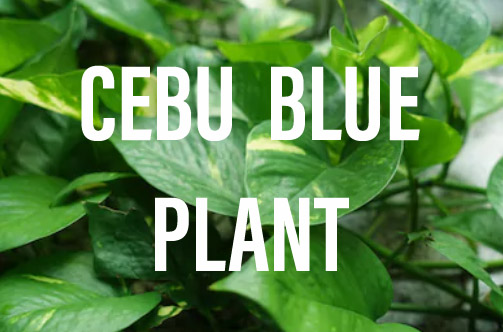Are you interested to know about the unique plant with totally different structures in its juvenile and mature form? Let’s get to know the Cebu Blue plant. This unique plant is truly a surprise by Mother Nature. It belongs to the genus ‘Epipremnum’ and the species name is ‘Pinnatum’.
Epipremnum pinnatum ceba blue is a species of flowering plant belonging to the family Araceae. These are evergreen, perennial vines native to Cebu Island of the Philippines and commonly found in Asian, North Australian, and European countries. The Cebu Blue plant has two different forms. One form is in its young or juvenile phase and the other outlook is in its mature phase.
These vines of rare Epipremnum can grow from 4 to 10 feet in length. These are low maintenance and easy to grow indoor plants that can do equally well in the outdoor environment. In this article, we will discuss the basic features of Cebu Blue along with its care and propagation.
Commons Names of Cebu Blue Plant
This plant is commonly known as:
- Devil’s ivy.
- Centipede Tongavine.
- Dragon-tail plant.
- Blue Pothos.
- Schindapsus aureum.
- Philodendron Cebu Blue Plant.
- Tibatib in the Philippines.
Difference between young and Adult Cebu Blue Plant

In this section, we will study the basic differences which are seen in the outlook and nature of the Cebu Blue Plant in its youth and maturity.
The juvenile form of the Plant:
Leaves:
In this phase, the leaves have a prominent bluish-gray or silver shade. The beauty of this plant is that the leaves of a single plant have many different shades like green, bluish-green, blue, and silver. These shades look even more prominent and beautiful in bright light. They are oval or elongated in shape with a length of 2 to 3 inches. The plant in this phase is commonly called the “European house plant” because of being a common choice for indoor decoration in the European region.
Habit:
The immature Blue Cebu is terrestrial in nature and grows on its own without any support. This stage usually forms dangling sleek vines in beautiful hanging plant baskets.
The mature form of the Plant:
Leaves:
The leaves turn green with specific zig-zag divisions that come up to the midrib of the leaf. Leaves at this stage resemble the fronds of a palm tree and are usually 1 to 3 feet in length.
Habit:
Mature Blue Cebu plants are climbers of epiphyte nature.
Cebu Blue and Monstera Plants
The Blue Cebu in its mature form is sometimes confused with Monstera plants due to the similar leaf structure. However, the Monstera plants don’t have the typical hard ridge found throughout the stem of the Cebu Plant.
Philodendron Cebu Blue Plant

As the Epipremnum and Philodendron are the genera of the flowering plants of the Araceae family, the Epipremnum Pinnatum ceba blue is sometimes commonly known as the Cebu blue Philodendron
Cebu Blue Pothos Plant
This is pretty interesting to note the Cebu Blue is commonly called Cebu Blue Pothos but it is not a true pothos. However, it has a striking resemblance with the pothos plants. Its features and low maintenance requirements are very much similar to that of pothos and it dwells well along with other such plants.
Care of Cebu Blue Plant
Important features regarding the care and requirements of the plant are mentioned below:
Water Requirements:
The water requirements of the Cebu Blue Plant are medium. Watering the plant once or twice a week is recommended. The frequency should be increased on hotter days. It is important to keep the soil moist as the plants are native to rain forests.
Sunlight Requirement:
The plant can survive well in lesser light however plenty of bright indirect light can enhance the beauty of the plant and its leaves.
In an outdoor environment, filtered indirect sunlight is suitable like the shade of a tree or some wall. Intense direct sun exposure may burn the leaves of the plant.
Soil Requirements:
The plant needs well-drained moist soil. And the type of soil is not specific as the philodendron Cebu blue plant adapts well to any kind of commonly available soil.
Temperature Requirements:
The plant does well in temperature ranges from 60 to 80 degrees Fahrenheit.
Humidity Requirement:
The humidity requirements of this plant are moderate. It can bear dry days but only a few.
Fertilizer Requirement:
To get lush green foliage you can sprinkle some organic fertilizer twice a week in spring and summer. In winter the fertilizer requirement reduces to once a month.
Pot Requirements:
It has two potting options.
Hanging Pot:
If you hang the Blue Pothos from a wall hanging pot, it will remain in its immature phase. In the wild, when the plant losses its grip on the tree trunk it starts dangling down. The dangling from its leaves starts getting smaller in size and ultimately stops growing further. So the plant in a dangling pot will give a good look like a hanging plant but will not turn mature and strong.
Pot with support:
If you add moss support to a pot on the ground, the philodendron Cebu blue will start climbing it and will develop into a beautiful and mature plant. This is the growth pattern of the Blue Pothos in the wild where they take the support of a tree and climb on it getting stronger and beautiful. So if you want to see a mature and beautiful Pothos Cebu Blue plant, you must add support in the pot of the plant.
Growth Zone:
The hardiness zone for growth is 9 to 11.
Propagation of Cebu Blue Plant
The Philodendron Cebu Blue is very easy to propagate. People with minimum knowledge and experience of gardening can also do well. The method of propagation is typical like the philodendron members. It is explained below:
Propagation by Cutting of Stem Strands:
- Use a sharp knife to cut about three to four strands from the plant, each of about 7 to 10 inches in length.
- Now cut the lower two to three leaves near the nodes or the aerial roots on the stem.
iii. Now dip the stems with the nodes in the water jar. Make sure to dip at least two nodes in the water keeping the rest of the stem out of the water. - Now put the jar in a place with plenty of indirect sunlight and wait for the roots to develop.
- After about three to four weeks, tiny roots will start developing from the nodes which will take a few weeks to develop a proper root system.
- Once the roots are developed properly, you can transfer the plant to the soil.
You can directly plant the stem cuttings in the moist soil and wait for the shoots to grow to be a sign of successful propagation.
vii. The soil of the pot should be moist and well-drained.
Propagation By single leaf:
- You can also cut a single leaf with an inch of stem at the base with a single node.
- Now dip the stalk of the leaf along with the basal stem in a small jar. Make sure to keep the leaf upright and out of the jar.
iii. Tiny roots will develop from even a single node dipped in the water. You need to give it some time in the water to develop some leaves and stems before transferring them to the soil.
Problems of Cebu Blue Plant
Common problems are discussed below:
Yellowing and Abnormal shape of leaves:
When the plant is not provided with enough water the leaves turn flattered in shape and yellow in shade. You need to see your watering routine and rectify it accordingly.
Browning of Leaves:
If the leaves are turning brown, it could be a sign of excess sunlight which has simply burnt the leaves. It could be due to overwatering or the high addition of fertilizer.
In such cases, you always need to observe the place and routine of the plant and manage it according to its required levels.
Pests Attack:
It is susceptible to common pests like spider mites and mealybugs which can be controlled by pesticide sprays or by wiping the leaves. While doing these measures, never forget to follow safety measures like gloves and masks to avoid harmful effects.
Uses of the Cebu Blue Plant
Indoor Ornamental Plant:
This is a common plant used for indoor decorations.
Vivariums/terrariums :
The plant is popular to be used in vivariums or terrarium used for animals because of its vine-like structure. The vine grows rapidly and can be trimmed/ pruned if required. Here the plant is kept dangling, so the plant will not get mature. Consequently, the leaves will remain small with shades of blue.
Frequently Asked Questions
Is Cebu blue pothos rare?
Epipremnum pinnatum is a beautiful, rare and low maintenance pothos plant. It is quite popular due to its silvery-blue leaves which glow in the right kind of light.
What is so special about Cebu blue pothos?
Cebu blue is a beautiful, lush green vine that can be added to any indoor or outdoor setting. It is quite easy to care for and adds a lot of aesthetics to your area. The pothos plant is well known for its silver-blue leaves and their quality to glow in the light.
Related Posts:
Conclusion
The Cebu Blue plants are unique plants from the family Araceae. Their juvenile and mature forms are totally different from each other. Young leaves are small with shades of gray and blue while mature leaves are divided into a typical palm-like pattern.
If kept dangling in hanging pots, you can even preserve their youth. The Cebu Blue plant needs to be supported by some upright structure like a tree(wild environment) or moss pole(domestic environment) to get mature. Easy to grow and low maintenance Blue Cebu Plants are a common choice for indoor decorative plants.

